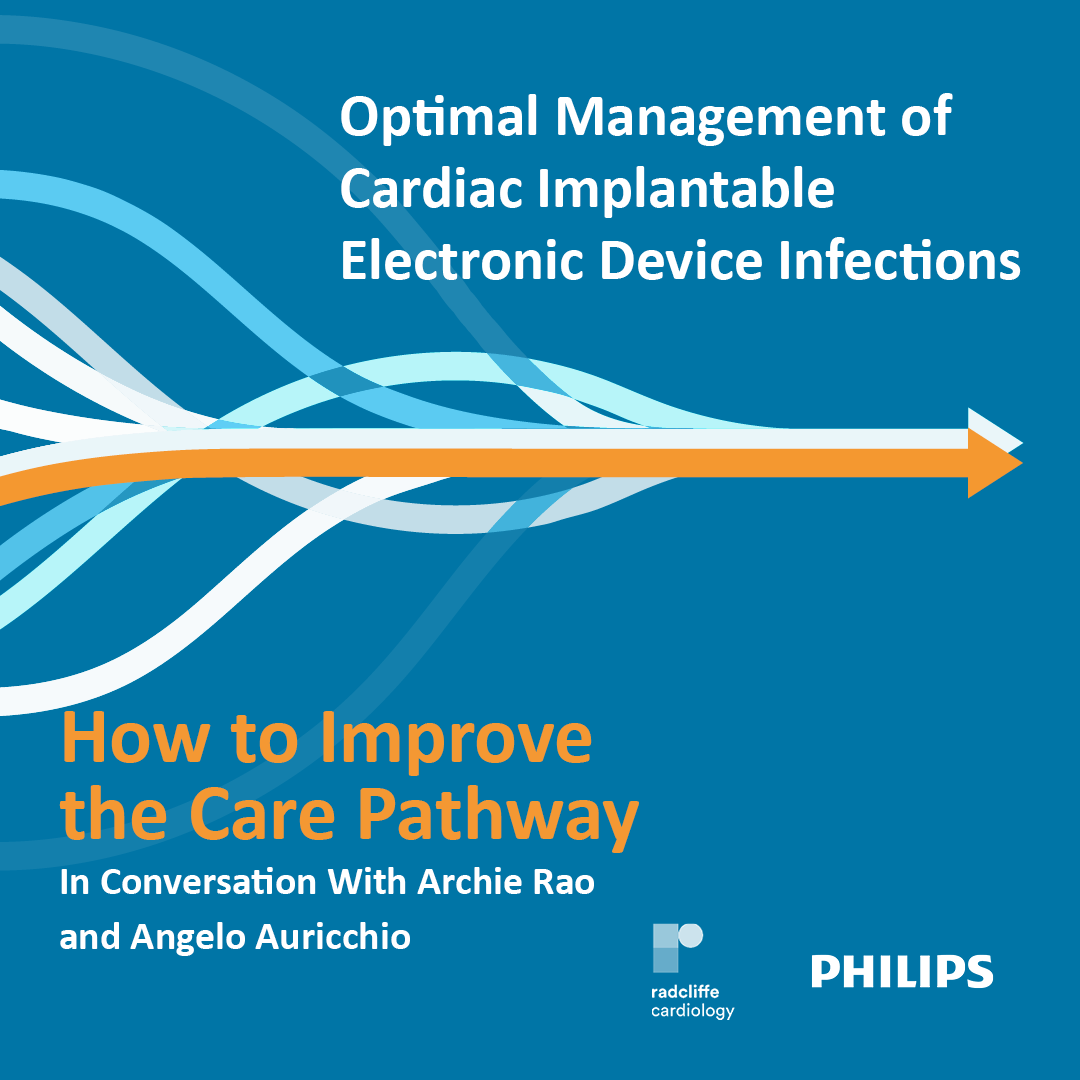
Optimal Management of Cardiac Implantable Electronic Device Infections – Ep.7: How to Improve the Care Pathway
An infection can have serious consequences for patients with a pacemaker or defibrillator when not treated appropriately. In this episode, Angelo Auricchio and Archie Rao explore which practical changes can be made to your clinical setting to improve these patients’ pathway.
Read MoreRead Less
This series is supported by Philips.
Read MoreRead Less
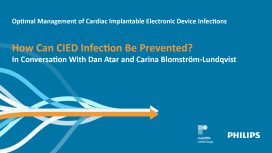
Patients with a pacemaker or defibrillator have a risk of having a device-related infection. Discover in this episode which actions can be taken to reduce the risk for infection. From pre-procedure planning to post-operative care, Dan Atar, Editor-in-Chief of the scientific journal ‘Cardiology’, and Carina Blomström-Lundqvist, lead author on the international consensus document addressing this topic, will discuss preventative measures for CIED infection.
This series is supported by Philips.
Read More
This series is supported by Philips.
All Episodes

Patients with a pacemaker or defibrillator have a risk of having a device-related infection. Discover in this episode which actions can be taken to reduce the risk for infection. From pre-procedure planning to post-operative care, Dan Atar, Editor-in-Chief of the scientific journal ‘Cardiology’, and Carina Blomström-Lundqvist, lead author on the international consensus document addressing this topic, will discuss preventative measures for CIED infection.
This series is supported by Philips.
Read More
This series is supported by Philips.
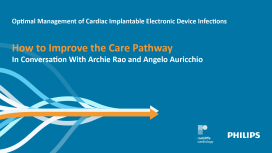
An infection can have serious consequences for patients with a pacemaker or defibrillator when not treated appropriately. In this episode, Angelo Auricchio and Archie Rao explore which practical changes can be made to your clinical setting to improve these patients’ pathway.
This series is supported by Philips.
Read More
This series is supported by Philips.
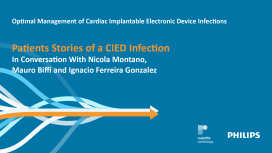
When the pacemaker or the defibrillator of a patient becomes infected, and if it's not immediately treated correctly, it can be a very emotional journey for the patient. Prof Biffi and Prof Ferreira have treated many CIED infection patients and often see cases where treatment was inappropriate or unnecessarily delayed. They share two touching patient stories with Prof Nicola Montano, physician in internal medicine. They discuss how these patients fell through the cracks of the diagnostic and therapeutic pathway and the devastating consequences for the patient.
This series is supported by Philips.
Read More
This series is supported by Philips.
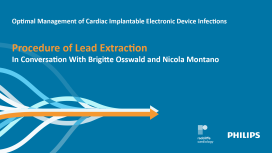
Infection of a cardiac electronic implantable device (CIED) is a rare, but serious, complication. When this happens, the removal of the entire system, generator and leads, is the only correct way to treat the infection. What happens during a procedure with lead extraction? Brigitte Osswald, an expert in the field who has performed more than 3,500 lead extraction procedures, talks to Nicola Montano, a physician in internal medicine, about the fundamentals of the procedure and explains why and how this is lifesaving for her patients.
This series is supported by Philips.
Read More
This series is supported by Philips.
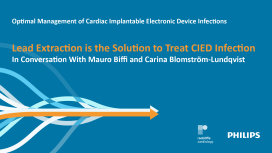
Infection of a cardiac electronic implantable device (CIED) is a rare, but serious complication. We now know that, because of the appearance of biofilm on implants, these infections cannot be treated by antibiotics alone. As such, Worldwide Cardiac Society guidelines recommend complete system removal of all hardware, including the leads, when an infection is present. Although the guidelines are clear, too many patients continue to not get the appropriate treatment. Why is that? Mauro Biffi and Carina Blomström-Lundqvist, both experts in the field of lead extraction, see a lot of patients fall through the cracks. They discuss why and what the consequences are of not extracting in time but also: what is the recommended care pathway to improve the outcomes.
This series is supported by Philips.
Read More
This series is supported by Philips.
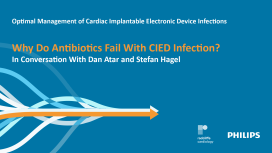
Although rare, cardiac implantable electronic device (CIED) infections may occur at any timepoint in the lifecycle. It is important to remain alert and recognise signs early. Traditionally, antibiotics alone are used to treat infection. But for CIED infections, when treated with antibiotics only, the relapse rate varies between 50 and 100 percent. But why is that? Dan Atar, Editor-in-Chief of the scientific journal ‘Cardiology’, and infectiologist Stefan Hagel, not only challenge the traditional point of view but tear down the decades of belief which surround it. Why are antibiotics not doing the job? What are the consequences? What is the solution? Why are infections sometimes overlooked and what is the action to change that in your practice?
This series is supported by Philips.
Read More
This series is supported by Philips.
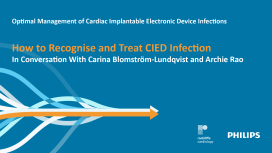
Although rare, infection of a pacemaker or a defibrillator is an important complication which must and can be treated effectively. Cardiac electronic implantable device (CIED) infection is a Class I indication for extraction but recent data has demonstrated that less than 2 in 10 patients receive appropriate treatment. Prof Carina Blomström-Lundqvist, Swedish Professor of Cardiology, and Dr Archie Rao, British consultant cardiologist, are both passionate about this topic. Carina Blomström-Lundqvist is the lead author of the European CIED infection guidelines and Archie Rao has led a gap analysis into the knowledge of CIED infection and treatment. They explain how to recognise a patient at risk and what to do to provide best outcomes for your patient.
This series is supported by Philips.
Read More
This series is supported by Philips.
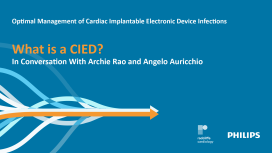
Patients with a cardiac implantable electronic device (CIED), like a pacemaker or a defibrillator, can be of all ages and have different types of implants. You have probably encountered at least one of these in your everyday practice. In this episode, Angelo Auricchio and Archie Rao, both specialists in this area, will discuss types of CIEDs and what they do. They will highlight potential complications with focus on infection. CIED infection is frequently under-recognised and potentially life-threatening. The good news is, it is treatable.
This series is supported by Philips.
Read More
This series is supported by Philips.

Patients with a pacemaker or defibrillator have a risk of having a device-related infection. Discover in this episode which actions can be taken to reduce the risk for infection. From pre-procedure planning to post-operative care, Dan Atar, Editor-in-Chief of the scientific journal ‘Cardiology’, and Carina Blomström-Lundqvist, lead author on the international consensus document addressing this topic, will discuss preventative measures for CIED infection.
This series is supported by Philips.
Read More
This series is supported by Philips.

An infection can have serious consequences for patients with a pacemaker or defibrillator when not treated appropriately. In this episode, Angelo Auricchio and Archie Rao explore which practical changes can be made to your clinical setting to improve these patients’ pathway.
This series is supported by Philips.
Read More
This series is supported by Philips.

When the pacemaker or the defibrillator of a patient becomes infected, and if it's not immediately treated correctly, it can be a very emotional journey for the patient. Prof Biffi and Prof Ferreira have treated many CIED infection patients and often see cases where treatment was inappropriate or unnecessarily delayed. They share two touching patient stories with Prof Nicola Montano, physician in internal medicine. They discuss how these patients fell through the cracks of the diagnostic and therapeutic pathway and the devastating consequences for the patient.
This series is supported by Philips.
Read More
This series is supported by Philips.

Infection of a cardiac electronic implantable device (CIED) is a rare, but serious, complication. When this happens, the removal of the entire system, generator and leads, is the only correct way to treat the infection. What happens during a procedure with lead extraction? Brigitte Osswald, an expert in the field who has performed more than 3,500 lead extraction procedures, talks to Nicola Montano, a physician in internal medicine, about the fundamentals of the procedure and explains why and how this is lifesaving for her patients.
This series is supported by Philips.
Read More
This series is supported by Philips.

Infection of a cardiac electronic implantable device (CIED) is a rare, but serious complication. We now know that, because of the appearance of biofilm on implants, these infections cannot be treated by antibiotics alone. As such, Worldwide Cardiac Society guidelines recommend complete system removal of all hardware, including the leads, when an infection is present. Although the guidelines are clear, too many patients continue to not get the appropriate treatment. Why is that? Mauro Biffi and Carina Blomström-Lundqvist, both experts in the field of lead extraction, see a lot of patients fall through the cracks. They discuss why and what the consequences are of not extracting in time but also: what is the recommended care pathway to improve the outcomes.
This series is supported by Philips.
Read More
This series is supported by Philips.





